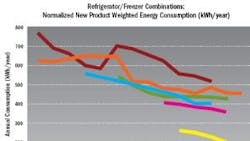Appliances more efficient in some countries than in others
Last year the International Energy Agency began collecting information on efficiency levels in home appliances used in 11 countries that include the US, EU, Australia, Korea, Canada, and others. It recently completed its data collection on TVs and on fridges and freezers. The point of the exercise was to provide comparisons of the performance of products across national boundaries and seek to identify potential key factors that may cause these differences.
The commission found relatively little difference in energy consumption among cold appliances in various countries. They did, however, find wide disparities in rates of improvement in efficiencies among countries. The thinking is, though, that much of this improvement in efficiency may come from rising product volumes. Markets that tend to perform best were those where mandatory labelling and/or minimum energy performance standards (MEPS) were introduced earlier.
Nevertheless, the commission says the explosive growth in ownership levels in China is more than outweighing any overall energy/efficiency gains made elsewhere (Chinese products are improving rapidly).
On the TV front, data indicates that in 2009 LCD screens were over 35% more efficient than plasma screens (measured using Energy Efficiency Index, EEI, as proposed for the European energy label scheme). Efficiency of all types of sets rose slowly in recent years with efficiency improvement evident for both LCD and plasma screens.
The commission says on-mode power in Watts is probably the most useful indicator to track national consumption trends. Average on-mode power for new televisions was in the region of 74 W for CRT screens (in 2007); 134 W for LCD screens (2009); and 287 W for plasma screens (2009). The average new plasma screen consumes more than twice as much power as the average new LCD screen. And screen size significantly affects total consumption. There's evidence that screen diagonal size may have grown by some 40% since 2000, and this expansion added 60% to typical TV energy consumption. But since 2007, screen size has only grown a few percent. The commission figures new energy efficient technology may offset the impact of bigger screens.
The news is good for standby consumption; it is heading for less than 1W in 2010 for almost all new televisions. But other kinds of stand-by modes that consume more power are becoming available, as to enable rapid starts. The advent of such technologies as well as those for Internet-enabled televisions, televisions with multiple tuners, and so forth, signal a need for better quality and more consistent energy performance data. The commission says it should be easier to get such data now that energy labels for televisions are emerging in several regions worldwide.
More complete data is available at the IEA site: http://mappingandbenchmarking.iea-4e.org/matrix
